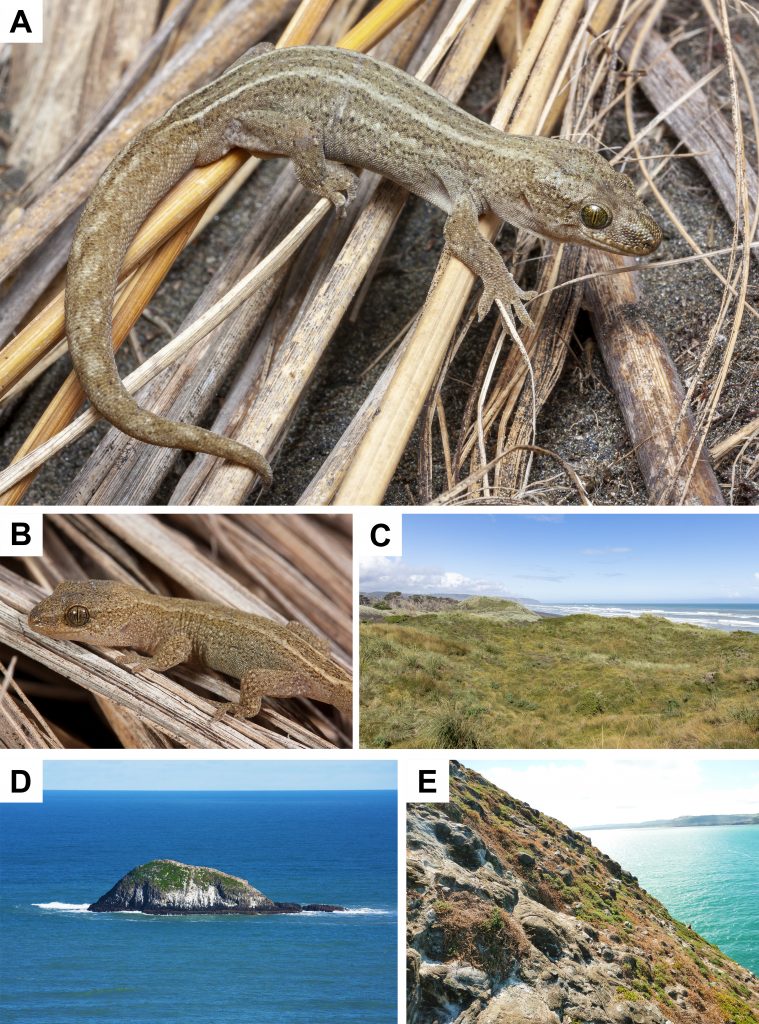Dr. Sarah Wells from the Applied Molecular Solutions Research Centre is an author on a new paper that describes a new species of gecko from Auckland, New Zealand.
The Woodworthia maculata species complex consists of around 14 putative, and yet mostly currently undescribed, species. The majority of these occur in the South Island, with only one species within the group being known from the North Island, Woodworthia maculata senso stricto. In 2012 a member of the public collected of a specimen from Woodhill Forest, behind Te Oneone Rangatira/ Muriwai Beach in Auckland. This specimen confirmed previous suspicions that Woodworthia geckos from the west coast of the North Island were morphologically distinct from Woodworthia maculata senso stricto. This prompted further visits to nearby Oaia Island approximately 1.3 km off the coast of Muriwai township to collect samples for morphological and DNA analysis, and a visit to Auckland Museum to measure more specimens.
In association with Auckland Council and local mana whenua (the indigenous Māori people of New Zealand who have historic and territorial rights over the land), Ngāti Whātua o Kaipara, delimiting surveys were also carried out on Te Korowai-o-Te-Tonga/ South Kaipara Peninsula to determine the extent of the range of the population.

FIGURE 1. In-life images of W. korowai sp. nov. and its habitat, illustrating: A, adult female from Te Oneone Rangatira/ Muriwai Beach, Auckland; B, juvenile from Te Oneone Rangatira/ Muriwai Beach, Auckland; C, typical duneland habitat of W. korowai on Te Korowai-o-Te-Tonga/ South Kaipara Peninsula; D, Oaia Island off the coast of Muriwai; and E, habitat of W. korowai on Oaia Island’s eastern face.
This gecko has distinctive dorsolateral striping (Fig. 1). Detailed morphological and mitochondrial DNA analysis subsequently confirmed this gecko as a new species. Molecular clock dating revealed that this species diverged from its common ancestor with Woodworthia maculata senso stricto around 3 million years ago in the mid to late-Pliocene.
Following consultation with Ngāti Whātua o Kaipara this new species was gifted the name Woodworthia korowai, Korowai gecko. The specific epithet is from the te reo Māori word korowai, referencing Te Korowai-o-Te-Tonga, the traditional name for South Head or South Kaipara Peninsula where the stronghold of this species occurs. Korowai is also a Māori term for a cloak, some of which the colour and patterns closely resemble those of the gecko. Furthermore, the English translation of Te Korowai-o-Te-Tonga (“the cloak of the south”) represents a metaphor for the covering, hiding, or concealing the species’ existence until relatively recently.

FIGURE 2. Inferred phylogenetic relationships of the genus Woodworthia, and distributions of the three Woodworthia congeners included in morphological analyses. Map of New Zealand shows the distributions of W. maculata (cyan blue), W. “Mt Arthur” (purple), and W. korowai sp. nov. (yellow). Light blue colour along the east coast in the inset map represents the presumed historical distribution of W. maculata between Whangarei and Kawakawa Bay (there are no verified records from this area but the proximity of islands supporting W. maculata to the mainland suggests they once occurred there). Maximum likelihood tree reconstructed from the mitochondrial NADH dehydrogenase subunit 2 (ND2) dataset. Posterior probabilities (PP) and bootstrap support (BS) values are indicated with grey or black dots at the nodes as described in the legend. Clades with PP < 0.95 or BS < 0.8 are not presented. Zoomed-in tree shows relationships within the genus Woodworthia.
Woodworthia korowai is largely restricted to coastal habitats such as duneland, coastal shrubland, and exotic Monterey pine (Pinus radiata) plantation on mainland New Zealand and exposed rock and prostrate herbfields on Oaia Island (Fig. 1). Due to it’s restricted distribution from Muriwai township, Oaia Island, and north onto Te Korowai-o-Te-Tonga/ South Kaipara Peninsula it is currently listed as “Nationally Vulnerable” under the New Zealand Threat Classification System. Threats to the species include recreational four wheel driving in the Muriwai/ Woodhill sand dunes which destroys the duneland habitat that the gecko is found in.
Click here to access the full text of the article.
Van Winkel, D., Wells, S. J., Harker, N., & Hitchmough, R. A. (2023). On the sand and among the crowds: a new species of Woodworthia gecko (Reptilia: Diplodactylidae) from Auckland, Aotearoa/New Zealand. Zootaxa, 5374(2), 263-294. DOI: 10.11646/ZOOTAXA.5374.2.7
